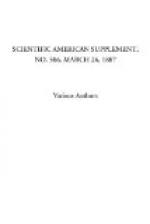To make this parachute, we cut a circle ten feet in diameter out of a piece of calico, and divide its circumference into ten or twelve equal parts. At each point of division we attach a piece of fine hempen cord about three feet in length, and connect these cords with each other, as well as with the suspension chain, by ligatures that are protected against the fire by means of balls of sized paper.
In rockets designed to receive these parachutes, a small cavity is reserved at the extremity of the cartridge for the reception of 225 grains of powder. To fill the pot, the chain, d, is rolled spirally around the box, c, and the latter is covered with the parachute, e, which has been folded in plaits, and then folded lengthwise alternately in one direction and the other.
The parachute port-fire consists of a cardboard tube of from quarter to half an inch in diameter, and from four to five inches in length, closed at one extremity and filled with star paste. This is connected by a brass wire with a cotton parachute eight inches in diameter. A rocket pot is capable of holding twenty of these port-fires.
Parachute fires and port-fires are used to advantage in the operation of signaling.—La Nature.
* * * * *
IMPROVEMENT IN LAYING OUT FRAMES OF VESSELS—THE FRAME TRACER.
By GUSTAVE SONNENBURG.
To avoid the long and time-consuming laying out of a boat by ordinates and abscissas, I have constructed a handy apparatus, by which it is possible without much trouble to obtain the sections of a vessel graphically and sufficiently accurate. The description of its construction is given with reference to the accompanying cut. A is a wooden rod of rectangular section, to which are adapted two brackets, a_{1} a_{2}, lined with India rubber or leather; a_{1} is fixed to the wood, a_{2} is of metal, and, like the movable block of a slide gauge, moves along A. In the same plane is a second rod, perpendicular to A, and attached thereto, which is perforated by a number of holes. A revolving pin, C, is adapted to pass through these holes, to which a socket, D, is pivoted, C acting as its axis. To prevent this pin from falling out, it is secured by a nut behind the rod. Through the socket, D, runs a rod, E, which carries the guide point, s_{1}, and pencil, s_{2}. Over s_{1} a rubber band is stretched, to prevent injury to the varnish of the boat. Back of and to A and B a drawing board is attached, over which a sheet of paper is stretched.
[Illustration: THE FRAME TRACER.]
The method of obtaining a section line is as follows: The rod, A, is placed across the gunwale and perpendicular to the axis of the boat, and its anterior vertical face is adjusted to each frame of the boat which it is desired to reproduce. By means of the brackets, a_{1} and a_{2}, A is fixed in place. The bolt, C, is now placed in the perforations already alluded to, which are recognized as most available for producing the constructional diagram. At the same time the position of the pencil point, s_{2}, must be chosen for obtaining the best results.




